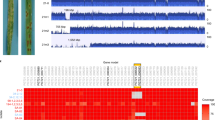Abstract
DISEASE-resistance genes introduced into cultivated plants are often rendered ineffective by the ability of pathogen populations to overcome host resistance1–3. The bacterial pathogen Xanthomonas campestris pathovar vesicatoria causes bacterial spot disease of tomato and pepper, and this pathogen has been shown to overcome disease resistance in pepper (Capsicum annuum) by evading the recognition and defence response of the host plant4–6. Numerous resistance genes to bacterial spot have been identified in pepper and its wild relatives, each providing resistance to specific races of X. c. vesicatoria7–13. The resistance gene Bs1, for example, provides resistance to X. c. vesicatoria strains expressing the avirulence gene avrBsl (ref. 11); Bs2 provides resistance to strains expressing avrBs2 (ref. 13) and so on. We now report that avrBs2 is highly conserved among strains of X. c. vesicatoria, and among many other pathovars of X. campestris. Furthermore, we find that avrBs2 is in fact needed for full virulence of the pathogen on susceptible hosts. This implies that plants carrying Bs2 can recognize an essential gene of the bacterial pathogen, which may explain why Bs2 confers the only effective field resistance to X. c. vesicatoria in pepper.
This is a preview of subscription content, access via your institution
Access options
Subscribe to this journal
Receive 51 print issues and online access
$199.00 per year
only $3.90 per issue
Buy this article
- Purchase on Springer Link
- Instant access to full article PDF
Prices may be subject to local taxes which are calculated during checkout
Similar content being viewed by others
References
Dahlbeck, D. & Stall, R. E. Phytopathology 69, 634–636 (1979).
Russell, G. E. Plant Breeding for Pest and Disease Resistance (Butterworths, London, 1978).
Johnson, R. in Durable Resistance in Crops (eds Lamberti, F., Waller, J. M. & Van der Graaf, M. A.) 5–26 (Plenum, New York, 1975).
Kearney, B. & Staskawicz, B. J. in Tomato Biotechnology (eds Nevins. D. J. & Jones, R. A.) 155–162 (Alan R. Liss, New York, 1987).
Kearney, B., Ronald, P. C., Dahlbeck, D. & Staskawicz, B. J. Nature 322, 541–543 (1988).
Kearney, B. & Staskawicz, B. J. J. Bact. 170, 143–148 (1990).
Starr, M. P. in The Prokaryotes (eds Starr, M. P., Stolp, M., Trüper, H. G., Balows, A. & Schlegel, H. G.) 742–764 (Springer, Berlin, 1981).
Hibbeid, A. M., Stall, R. E. & Bassett, M. J. Phytopathology 77, 1304–1307 (1987).
Kim, B. S. & Hartman, R. W. Pl. Dis. 69, 233–235 (1985).
Cook, A. A. & Guevara, Y. G. Pl. Dis. 68, 329–330 (1984).
Swanson, J. Kearney, B., Dahlbeck, D. & Staskawicz, B. Molec. Pl. Microbe Interact. 1, 5–9 (1988).
Bonas, U., Stall, R. E. & Staskawicz, B. Molec. gen. Genet. 218, 127–136 (1989).
Minsavage, G. V. et al. Molec PI. Microbe Interact. 3, 41–47 (1990).
Klement, Z. in Phytopathogenic Prokaryotes Vol. 2 (eds Mount, M. S. & Lacy, G. H.) 149–177 (Academic, New York, 1982).
Hibberd, A. M., Stall, R. E. & Basset, M. J. Pl. Disease 71, 1075–1078 (1987).
Southern, E. M. J. molec Biol. 98, 503–517 (1975).
Vieira, J. & Messing, J. Meth. Enzym. 153, 3–11 (1987).
Staskawicz, B., Dahlbeck, D., Keen, N. & Napoli, C. J. Bact. 169, 5789–5794 (1987).
Author information
Authors and Affiliations
Rights and permissions
About this article
Cite this article
Kearney, B., Staskawicz, B. Widespread distribution and fitness contribution of Xanthomonas campestris avirulence gene avrBs2. Nature 346, 385–386 (1990). https://doi.org/10.1038/346385a0
Received:
Accepted:
Issue Date:
DOI: https://doi.org/10.1038/346385a0
This article is cited by
-
Epidemiology, diversity, and management of bacterial spot of tomato caused by Xanthomonas perforans
Applied Microbiology and Biotechnology (2021)
-
Comparative genomics of Xanthomonas fragariae and Xanthomonas arboricola pv. fragariae reveals intra- and interspecies variations
Phytopathology Research (2020)
-
Advances in the Xoo-rice pathosystem interaction and its exploitation in disease management
Journal of Biosciences (2020)
-
Interfamily transfer of Bs2 from pepper to cassava (Manihot esculenta Crantz)
Tropical Plant Pathology (2019)
-
The OmpA Gene of Xanthomonas axonopodis pv. glycines is Involved in Pathogenesis of Pustule Disease on Soybean
Current Microbiology (2019)
Comments
By submitting a comment you agree to abide by our Terms and Community Guidelines. If you find something abusive or that does not comply with our terms or guidelines please flag it as inappropriate.



